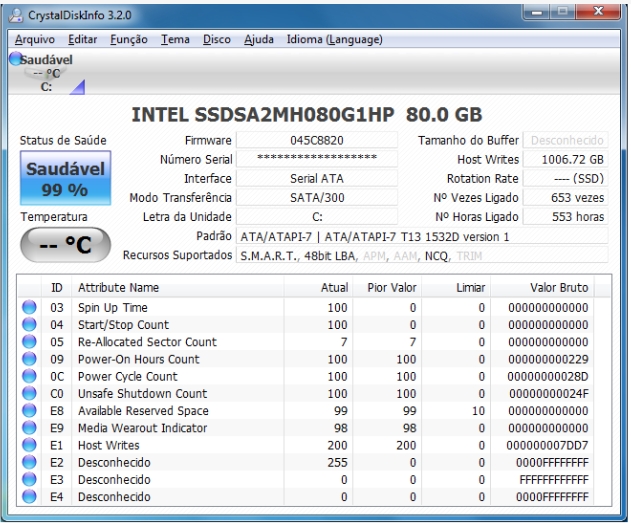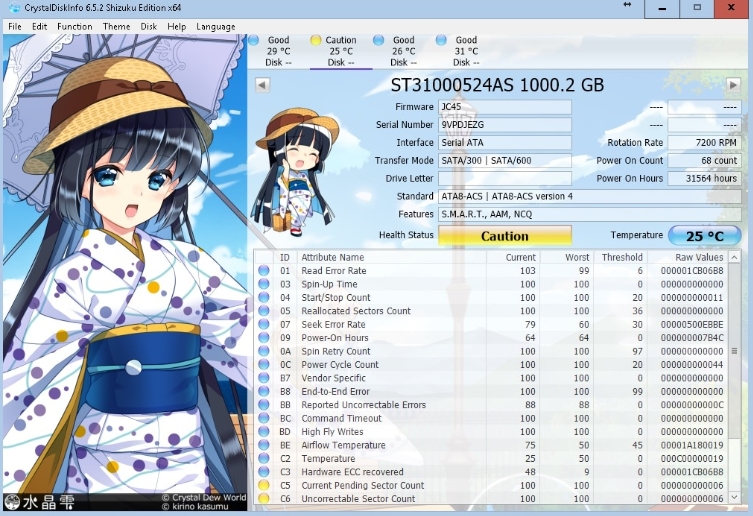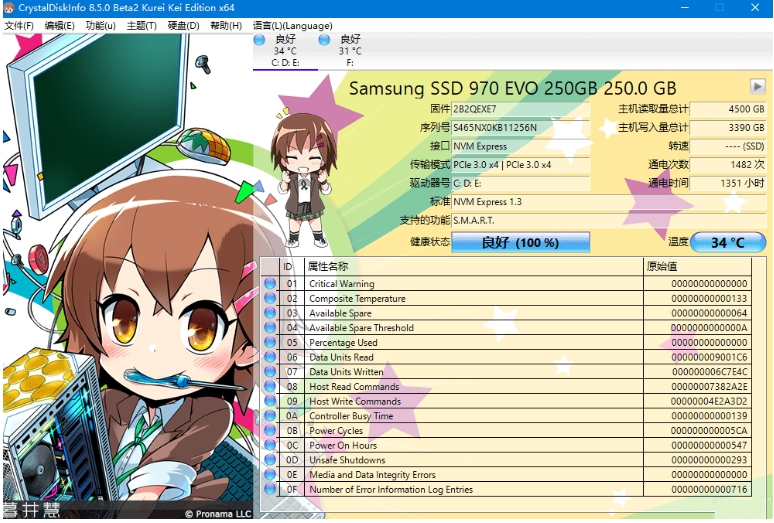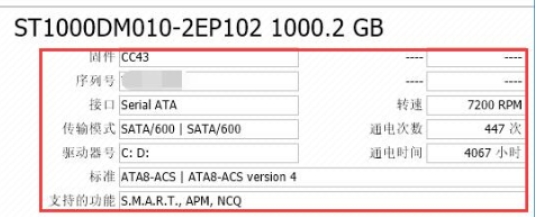 Software Tutorial
Software Tutorial
 Computer Software
Computer Software
 CrystalDiskinfo usage tutorial-What software is CrystalDiskinfo?
CrystalDiskinfo usage tutorial-What software is CrystalDiskinfo?
CrystalDiskinfo usage tutorial-What software is CrystalDiskinfo?
php editor Xinyi brings you a tutorial on how to use CrystalDiskinfo. CrystalDiskinfo is a free hard disk health monitoring software that can monitor the operating status and temperature of the hard disk in real time, helping users understand the health status of the hard disk in a timely manner and prevent data loss. This tutorial will introduce the functions and usage of CrystalDiskinfo software in detail, allowing you to easily master hard drive monitoring skills and ensure data security.

1. The origin of CrystalDiskInfo
As one of the three major components of a computer host, solid-state drive is the storage medium of the computer and is responsible for computer data storage. A good solid-state drive can speed up file reading and affect consumption. user experience. When consumers receive new devices, they can use third-party software or other SSD testing tools to test the performance of the hard drive and check the quality of the hard drive.

CrystalDiskInfo is a tool for monitoring and assessing the health of your computer's hard drive. It provides detailed hard drive information by reading the SMART (Self-Monitoring, Analysis and Reporting Technology) data of the hard drive, helping users understand the usage, health status and possible problems of the hard drive.

You can get a comprehensive, detailed and intuitive understanding of the hard drive health status and various parameters, including hard drive temperature, serial number, drive interface, power-on time, power-on times, etc. The software will also make an evaluation based on the S.M.A.R.T score and will issue an alert when the hard drive is about to be damaged.

2. How to use CrystalDiskInfo
first step
Open the CrystalDiskInfo obtained after decompression, and you can see all relevant information about the computer's local hard disk in the main page interface.

Step 2
Use the drop-down list to check the working status of the hard drive and various health values to find the point of damage.

third step
If the "Theme" tab is used, then under this tab we can also set the display size, font, color and other information of the window

the fourth step
Special reminder: when downloading this software, if the downloaded software interface is in English, you can modify the language of the interface through the "language" tab in the menu bar.

the fifth step
Click the "Function" button in the top menu bar, pull down the menu, and point the mouse to "Warning Function". You can set the warning method in the submenu.

Step 6
In the "Advanced Features" column of the "Features" option, you can select "AAM/APM Control Most Important".
Step 7
After completing the above steps, you will be able to set the noise and power properties of the hard disk to ensure that the most appropriate conditions can be adjusted when using the computer.

The above is the detailed content of CrystalDiskinfo usage tutorial-What software is CrystalDiskinfo?. For more information, please follow other related articles on the PHP Chinese website!

Hot AI Tools

Undresser.AI Undress
AI-powered app for creating realistic nude photos

AI Clothes Remover
Online AI tool for removing clothes from photos.

Undress AI Tool
Undress images for free

Clothoff.io
AI clothes remover

AI Hentai Generator
Generate AI Hentai for free.

Hot Article

Hot Tools

Notepad++7.3.1
Easy-to-use and free code editor

SublimeText3 Chinese version
Chinese version, very easy to use

Zend Studio 13.0.1
Powerful PHP integrated development environment

Dreamweaver CS6
Visual web development tools

SublimeText3 Mac version
God-level code editing software (SublimeText3)

Hot Topics
 1377
1377
 52
52
 How to use sql datetime
Apr 09, 2025 pm 06:09 PM
How to use sql datetime
Apr 09, 2025 pm 06:09 PM
The DATETIME data type is used to store high-precision date and time information, ranging from 0001-01-01 00:00:00 to 9999-12-31 23:59:59.99999999, and the syntax is DATETIME(precision), where precision specifies the accuracy after the decimal point (0-7), and the default is 3. It supports sorting, calculation, and time zone conversion functions, but needs to be aware of potential issues when converting precision, range and time zones.
 Can I retrieve the database password in Navicat?
Apr 08, 2025 pm 09:51 PM
Can I retrieve the database password in Navicat?
Apr 08, 2025 pm 09:51 PM
Navicat itself does not store the database password, and can only retrieve the encrypted password. Solution: 1. Check the password manager; 2. Check Navicat's "Remember Password" function; 3. Reset the database password; 4. Contact the database administrator.
 How to view database password in Navicat for MariaDB?
Apr 08, 2025 pm 09:18 PM
How to view database password in Navicat for MariaDB?
Apr 08, 2025 pm 09:18 PM
Navicat for MariaDB cannot view the database password directly because the password is stored in encrypted form. To ensure the database security, there are three ways to reset your password: reset your password through Navicat and set a complex password. View the configuration file (not recommended, high risk). Use system command line tools (not recommended, you need to be proficient in command line tools).
 Navicat's method to view PostgreSQL database password
Apr 08, 2025 pm 09:57 PM
Navicat's method to view PostgreSQL database password
Apr 08, 2025 pm 09:57 PM
It is impossible to view PostgreSQL passwords directly from Navicat, because Navicat stores passwords encrypted for security reasons. To confirm the password, try to connect to the database; to modify the password, please use the graphical interface of psql or Navicat; for other purposes, you need to configure connection parameters in the code to avoid hard-coded passwords. To enhance security, it is recommended to use strong passwords, periodic modifications and enable multi-factor authentication.
 How to delete rows that meet certain criteria in SQL
Apr 09, 2025 pm 12:24 PM
How to delete rows that meet certain criteria in SQL
Apr 09, 2025 pm 12:24 PM
Use the DELETE statement to delete data from the database and specify the deletion criteria through the WHERE clause. Example syntax: DELETE FROM table_name WHERE condition; Note: Back up data before performing a DELETE operation, verify statements in the test environment, use the LIMIT clause to limit the number of deleted rows, carefully check the WHERE clause to avoid misdeletion, and use indexes to optimize the deletion efficiency of large tables.
 Can mysql and mariadb be installed on the same server?
Apr 08, 2025 pm 05:00 PM
Can mysql and mariadb be installed on the same server?
Apr 08, 2025 pm 05:00 PM
MySQL and MariaDB can be installed simultaneously on a single server to meet the needs of different projects for specific database versions or features. The following details need to be paid attention to: different port numbers; different data directories; reasonable allocation of resources; monitoring version compatibility.
 How to add columns in PostgreSQL?
Apr 09, 2025 pm 12:36 PM
How to add columns in PostgreSQL?
Apr 09, 2025 pm 12:36 PM
PostgreSQL The method to add columns is to use the ALTER TABLE command and consider the following details: Data type: Select the type that is suitable for the new column to store data, such as INT or VARCHAR. Default: Specify the default value of the new column through the DEFAULT keyword, avoiding the value of NULL. Constraints: Add NOT NULL, UNIQUE, or CHECK constraints as needed. Concurrent operations: Use transactions or other concurrency control mechanisms to handle lock conflicts when adding columns.
 Can mysql connect to the sql server
Apr 08, 2025 pm 05:54 PM
Can mysql connect to the sql server
Apr 08, 2025 pm 05:54 PM
No, MySQL cannot connect directly to SQL Server. But you can use the following methods to implement data interaction: Use middleware: Export data from MySQL to intermediate format, and then import it to SQL Server through middleware. Using Database Linker: Business tools provide a more friendly interface and advanced features, essentially still implemented through middleware.



